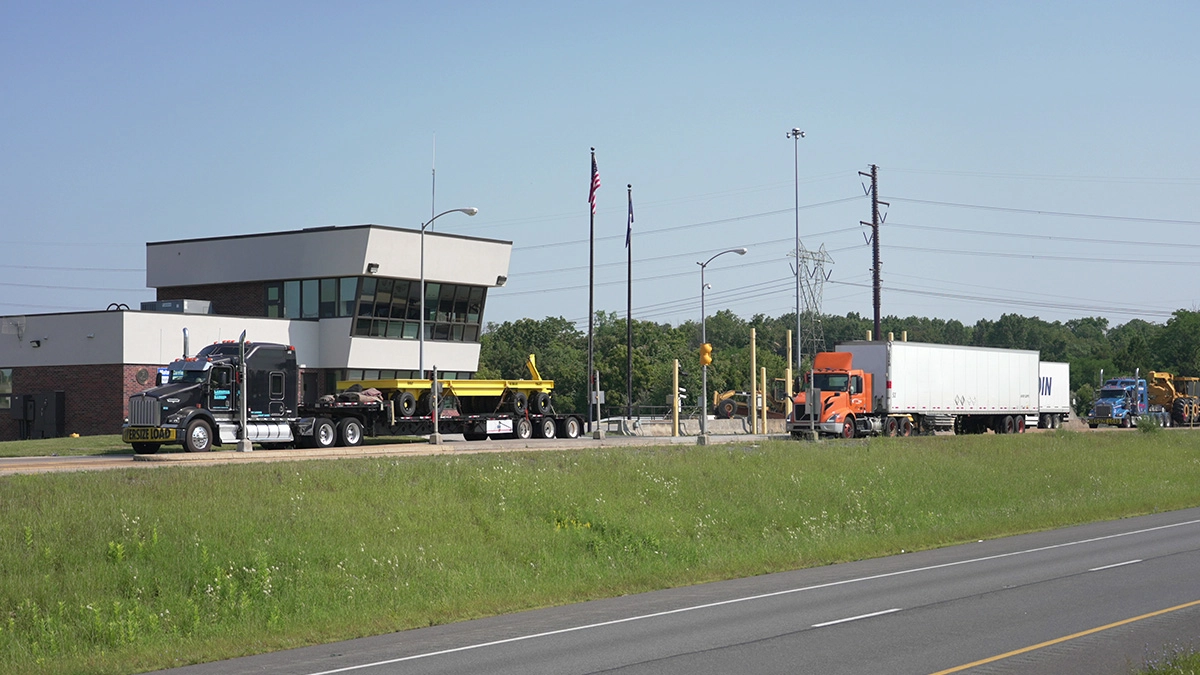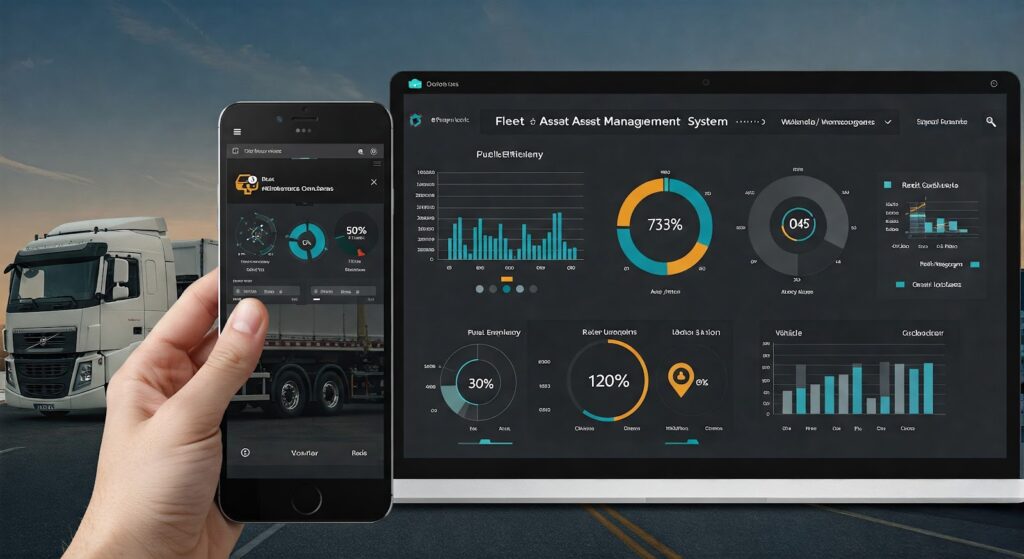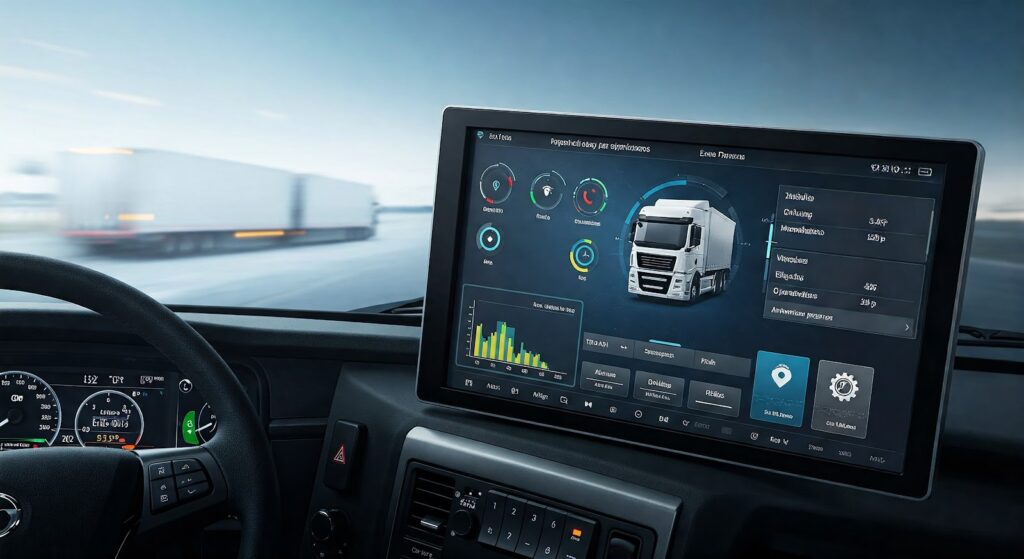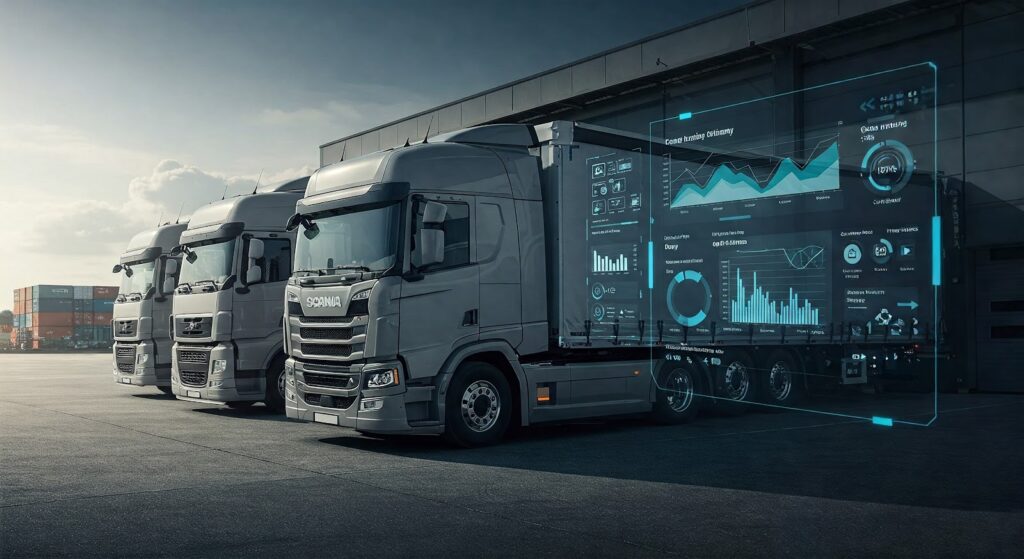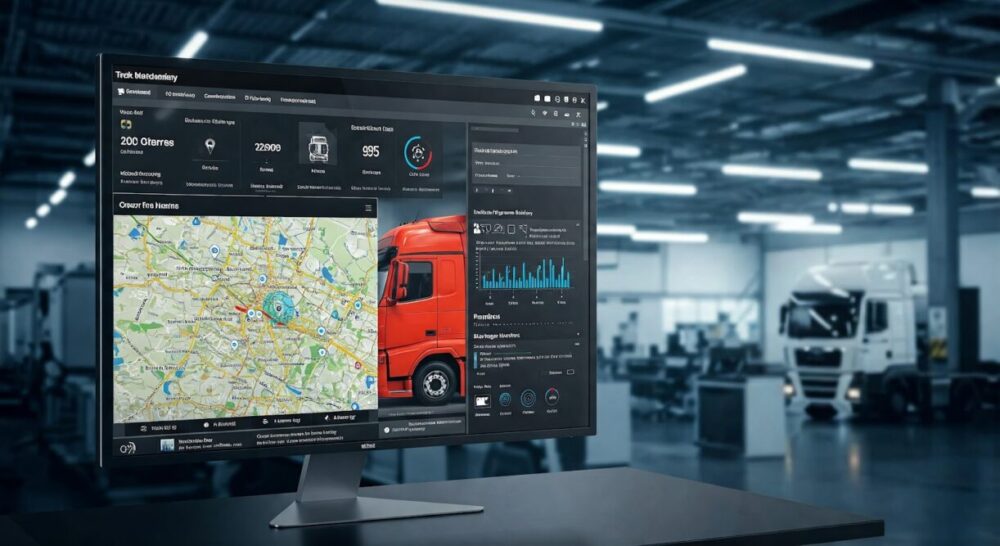
Managing a fleet that operates across multiple states or international borders presents a unique set of challenges that go beyond standard fleet management concerns. Unlike localized operations, multi-state and cross-border fleets must navigate an intricate web of regulations, tax reporting requirements, toll systems, and compliance mandates, all of which can vary significantly between regions.
One of the biggest hurdles for fleet managers in multi-jurisdiction operations is ensuring regulatory compliance. Each state or country has its own commercial vehicle laws, including weight restrictions, emissions regulations, and hours-of-service (HOS) rules. Keeping up with these changes manually can be overwhelming, making it essential to have a fleet management system that automates compliance tracking and provides real-time alerts.
Another major challenge is toll management. Different states and countries have separate toll authorities, each with its own transponder system, pricing models, and payment methods. Without an integrated system to manage toll payments, fleets may encounter issues such as duplicate charges, delayed reimbursements, or violations due to missing toll registrations.
Additionally, fleets crossing multiple jurisdictions must comply with fuel tax reporting requirements, most notably the International Fuel Tax Agreement (IFTA) for U.S. and Canadian carriers. IFTA requires accurate tracking of fuel purchases and miles traveled in each jurisdiction, which can become a logistical nightmare if recorded manually. Errors in reporting can lead to penalties, audits, and unnecessary financial strain.
Given these challenges, choosing the right fleet management software is not just about selecting a system with standard GPS tracking and maintenance tools—it requires a comprehensive solution tailored to the complexities of multi-jurisdiction fleet operations. This article will explore the essential features to look for in fleet management software, how to evaluate different options, and best practices for ensuring seamless compliance and cost-effective operations in multi-state and cross-border environments.
1. Understanding the Challenges of Multi-State and Cross-Border Fleet Operations
Operating a fleet across multiple states or international borders requires a deep understanding of regional policies, infrastructure variations, and the technological capabilities needed to ensure seamless operations. Below are the key challenges fleets must navigate when expanding beyond a single jurisdiction.
A. Regulatory Differences: Navigating a Patchwork of Laws
Each state and country has its own commercial vehicle regulations, which can differ in terms of weight limits, emissions standards, safety inspections, and driver work hours. For example, while the U.S. Department of Transportation (DOT) enforces overarching safety standards, individual states may have additional requirements, such as unique inspection protocols or permit mandates for oversized loads. Similarly, if a fleet crosses into Canada or Mexico, operators must comply with different fuel regulations, licensing requirements, and customs procedures.
For fleet managers, this means staying up to date with legal changes, filing the correct paperwork, and ensuring that each vehicle and driver meets specific regional standards. Without automated compliance tracking, manually managing these requirements can quickly become a time-consuming and error-prone process.
B. Tolling Systems: Managing Multiple Payment Networks
Unlike local fleets that only need to register with a single toll authority, multi-state fleets must navigate multiple toll collection agencies, each with its own rules, transponders, and fee structures. For example, the E-ZPass system covers many Eastern U.S. states, while other regions use different networks like SunPass in Florida, FasTrak in California, and TxTag in Texas. International fleets encounter even more complexity when dealing with electronic tolling systems in Canada, Mexico, or the European Union.
Without a centralized toll management solution, fleets may experience:
- Overlapping transponder fees when vehicles require multiple devices for different toll networks.
- Incorrect charges or duplicate payments, leading to disputes with toll authorities.
- Delays in reimbursement for toll expenses, particularly for owner-operators or leased vehicles.
An effective fleet management system should integrate with multiple tolling networks, consolidate billing, and help fleets avoid toll violations and unnecessary expenses.
C. Fuel Tax Reporting & IFTA Compliance: Avoiding Costly Penalties
For fleets operating across the U.S. and Canada, the International Fuel Tax Agreement (IFTA) simplifies fuel tax reporting by allowing carriers to file a single quarterly tax return instead of separate reports for each state or province. However, this still requires meticulous record-keeping, including precise fuel purchase data, miles traveled in each jurisdiction, and tax rates that vary by location.
Key challenges fleets face with IFTA compliance include:
- Manual errors in mileage tracking leading to tax discrepancies and potential audits.
- Unclaimed tax refunds due to incomplete or missing fuel purchase records.
- Penalties for late or inaccurate filings, which can result in fines or even suspension of operations.
Fleet management software with IFTA automation can streamline the process by automatically logging fuel purchases, tracking miles driven per jurisdiction, and generating pre-filled tax reports, reducing the burden on fleet managers.
D. Driver Licensing & Work Restrictions: Adapting to Regional Requirements
In addition to maintaining vehicle compliance, fleet managers must ensure that drivers meet licensing requirements across different jurisdictions. While Commercial Driver’s Licenses (CDLs) are recognized nationwide in the U.S., additional permits may be required for specialized vehicles or hazardous materials transportation. Cross-border operations introduce further complexities, such as:
- Different work-hour limitations, where some regions impose stricter Hours of Service (HOS) regulations.
- Cross-border visa and permit requirements, especially when transporting goods internationally.
- Roadside inspection variations, which may require different documentation depending on the state or country.
Without a system that tracks driver credentials and regulatory updates, fleets risk compliance violations, operational delays, and potential fines.
E. Route Planning & Infrastructure Variations: Optimizing for Different Road Networks
Multi-state operations require fleet managers to consider differences in road infrastructure, including:
- State-specific trucking restrictions, such as bridge height limits, weight limits, and hazardous material transport bans.
- Seasonal road closures, particularly in areas affected by extreme weather, such as mountainous regions or northern states during winter.
- Congestion pricing and low-emission zones, which impact costs in urban areas with toll-based entry or pollution-based restrictions.
Advanced route optimization tools within fleet management software can account for these variables, minimize delays, and reduce fuel expenses by selecting the most efficient paths for each trip.
Why Addressing These Challenges Matters
Without a comprehensive software solution, fleet managers must manually track regulations, reconcile toll payments, calculate fuel taxes, and optimize routes, increasing the risk of errors and operational inefficiencies. The next section will explore the essential features fleet management software must include to help fleets overcome these challenges and ensure smooth multi-state or cross-border operations.
2. Key Features to Look for in Fleet Management Software
Selecting the right fleet management software for a multi-state or cross-border operation requires more than just basic tracking capabilities. It must address the unique complexities of operating across different jurisdictions, ensuring compliance, cost efficiency, and operational fluidity. Below are the critical features to prioritize when evaluating software solutions for fleets that traverse multiple regions.
A. Automated Regulatory Compliance Monitoring & Dynamic Rule Updates
Managing compliance across different jurisdictions is a constant challenge, as regulations change frequently. The best fleet management software should have:
- Automated rule updates that adjust compliance settings as regulations change in different states, provinces, or countries.
- Geofencing-based compliance alerts, notifying fleet managers when a vehicle enters a region with specific restrictions (e.g., low-emission zones, weight limits).
- Automated document management, ensuring vehicle registrations, permits, and safety inspections are up to date and accessible digitally for audits or roadside inspections.
- Custom compliance reporting, allowing fleet managers to generate detailed reports tailored to specific regulatory bodies, reducing the risk of fines and operational delays.
B. Integrated Toll Processing & Violation Prevention
A critical feature for multi-state and cross-border fleets is seamless toll management that eliminates manual reconciliation and reduces unnecessary toll fees. Look for software that includes:
- Real-time toll tracking, providing instant visibility into toll charges as they occur.
- Automated transponder management, allowing fleets to register, activate, and deactivate toll devices remotely.
- Duplicate charge prevention, ensuring that vehicles aren’t double-billed when using multiple toll networks.
- Toll avoidance routing, optimizing routes to minimize unnecessary toll expenses while balancing travel time and fuel efficiency.
By integrating toll payment processing within the fleet management system, operators can streamline billing, avoid disputes, and ensure timely reimbursements for toll-related costs.
C. Multi-Jurisdiction Fuel Tax & Expense Automation
A robust fleet management software should provide automatic tracking and reporting for fuel taxes, eliminating the need for manual data entry and reducing the risk of costly errors. The best solutions will offer:
- Automated fuel purchase tracking, linking directly to fuel card systems to log expenses in real-time.
- Mileage-based tax calculations, ensuring accurate fuel tax reporting per jurisdiction, compliant with IFTA or other applicable tax frameworks.
- Fuel efficiency analytics, helping fleet managers identify vehicles with excessive fuel consumption and uncover cost-saving opportunities.
- Automated refund eligibility tracking, identifying cases where fleets qualify for fuel tax refunds based on fuel usage and jurisdictional tax rates.
By automating these processes, fleet operators can ensure compliance while optimizing fuel costs across different regions.
D. Real-Time Cross-Border Vehicle & Asset Tracking
Multi-state and cross-border fleets require real-time tracking solutions that offer continuous visibility into vehicle movements across jurisdictions. A strong fleet management system should include:
- International GPS tracking, capable of working seamlessly across multiple countries without service disruptions.
- Multi-network connectivity, ensuring coverage even in remote areas by switching between different cellular providers or satellite networks.
- Live location sharing, allowing dispatchers to monitor vehicle positions and provide real-time updates to customers, shippers, or customs authorities.
- Geofencing & automated alerts, notifying managers when a vehicle crosses a state or national border, ensuring proper documentation and compliance measures are in place.
With these features, fleet managers can ensure that vehicles remain on track, avoid unauthorized route deviations, and respond quickly to operational disruptions.
E. AI-Powered Route Optimization for Cost & Compliance Efficiency
Advanced AI-powered route planning is a must-have for multi-jurisdiction fleets, helping optimize paths while balancing costs, tolls, and compliance requirements. Look for software that offers:
- Smart route adjustments, automatically recalculating paths based on real-time traffic, toll costs, and weather conditions.
- Cross-border customs clearance optimization, guiding drivers toward faster border crossings and avoiding routes with historically high congestion or inspection delays.
- Fuel-efficient route planning, minimizing travel through high-cost fuel regions to reduce operational expenses.
- Hazardous material (HAZMAT) routing, ensuring compliance with special transport regulations by directing vehicles along approved routes.
By leveraging AI-driven routing, fleets can reduce transit times, lower fuel expenses, and enhance overall efficiency while maintaining regulatory compliance.
F. Multi-Language & Multi-Currency Support for International Fleets
For fleets operating across multiple countries, software must accommodate language and currency differences to ensure seamless operations. The best platforms will provide:
- Multi-language driver interfaces, allowing drivers to receive instructions and alerts in their preferred language.
- Automated currency conversion, enabling accurate financial reporting when fuel, tolls, and expenses are recorded in different currencies.
- Region-specific tax configurations, ensuring that invoices, tax calculations, and financial reports align with local regulatory requirements.
By supporting multiple languages and currencies, fleet management software enhances usability and simplifies financial management for international fleets.
G. Secure Cloud-Based Data Access & Multi-Location Fleet Coordination
Fleets operating across multiple jurisdictions require a centralized, cloud-based platform that enables remote access and coordination across different locations. The ideal system should include:
- Multi-location data synchronization, ensuring that fleet managers in different states or countries can access the same real-time information.
- Role-based user access controls, allowing different levels of access for managers, drivers, and compliance officers based on their responsibilities.
- Data redundancy & backup features, preventing loss of critical fleet data due to system failures or cyber threats.
- Customizable dashboard views, enabling fleet managers to filter data based on regions, vehicle groups, or compliance categories.
Cloud-based fleet management solutions provide the flexibility and scalability needed to support growing, multi-jurisdiction operations without compromising data security or accessibility.
Why These Features Matter for Multi-State and Cross-Border Fleets
Fleet management software must go beyond basic tracking and compliance tools—it should be a comprehensive platform that automates regulatory updates, simplifies toll and fuel tax management, optimizes routes, and enhances cross-border visibility. By prioritizing these features, fleet operators can reduce administrative burdens, improve efficiency, and ensure that their operations remain fully compliant across all jurisdictions.
Comparing Software Solutions: What to Prioritize
Selecting the right fleet management software for a multi-state or cross-border operation requires more than just checking off a list of features. With a wide range of solutions available, fleet managers must assess how well a platform aligns with their specific needs, regulatory requirements, and long-term business goals. This section outlines key factors to consider when comparing different software solutions and provides a framework for making an informed decision.
Scalability: Choosing Software That Grows with Your Fleet
One of the most critical considerations is whether the software can scale as your fleet expands into new territories. Many fleet management solutions work well for small or localized operations but struggle with the demands of multi-jurisdiction compliance, tolling, and tax reporting.
Key questions to ask:
- Does the software support an unlimited number of vehicles and drivers?
- Can it handle operations across multiple states, provinces, or countries without requiring additional integrations?
- Does it offer modular features that can be added as business needs evolve?
- How does the pricing model change as your fleet grows? Are there hidden costs for scaling?
A scalable system ensures that as your fleet expands, you won’t need to invest in an entirely new solution or suffer from operational inefficiencies due to software limitations.
Regional & Industry-Specific Compatibility
Not all fleet management software solutions are designed to handle the unique regulatory and logistical challenges of multi-state and cross-border operations. Before making a decision, fleet managers should assess whether a solution is optimized for their specific industry and geographic footprint.
Key considerations:
- Does the software support compliance requirements for every state, province, or country where your fleet operates?
- Is it designed for specific fleet types (e.g., long-haul trucking, hazardous materials, refrigerated transport)?
- Can it integrate with region-specific toll networks, tax authorities, and customs agencies?
- Does it provide route optimization tailored to your industry (e.g., construction fleets avoiding restricted roads, refrigerated fleets prioritizing fuel efficiency)?
A solution that lacks regional compatibility can lead to compliance gaps, operational inefficiencies, and unexpected costs.
User Experience & Accessibility
No matter how powerful a fleet management solution is, it won’t be effective if it’s difficult to use. Fleet managers, dispatchers, drivers, and administrative teams all need access to the system, so usability is a crucial factor.
What to assess in the user experience (UX):
- Is the dashboard intuitive, with easy-to-navigate menus and real-time data visualization?
- Can drivers access key features (e.g., compliance alerts, route guidance) on a mobile-friendly interface?
- Does the platform support role-based access so that different users only see relevant data?
- Are reports easy to generate, customize, and export for audits or executive summaries?
A well-designed user experience minimizes training time, reduces errors, and ensures teams can quickly adapt to using the software.
Vendor Support, Training, and Service Reliability
Even the most advanced software is only as good as the support behind it. Multi-state and cross-border fleets need responsive customer service and reliable system uptime to keep operations running smoothly.
Key questions to ask about vendor support:
- Does the provider offer 24/7 customer service, particularly for urgent compliance or tolling issues?
- What is the average system uptime? Are there known reliability issues with downtime affecting operations?
- Does the company provide hands-on onboarding and training for fleet managers and drivers?
- Are there dedicated account managers available to assist with troubleshooting and optimization?
A provider with strong support services ensures that fleets can quickly resolve issues, avoid compliance risks, and maximize software performance.
Implementing the Right Fleet Management Software
Once a fleet management solution has been selected, proper implementation is crucial to maximize its benefits. Here’s a step-by-step approach to ensuring a smooth transition from selection to full-scale deployment.
1. Conduct an Internal Needs Assessment
- Identify your fleet’s biggest pain points—whether it’s compliance, toll tracking, route optimization, or operational visibility.
- Define key performance indicators (KPIs) to measure software success, such as reduced compliance violations, toll savings, and fuel efficiency improvements.
- Assess current workflows to determine how the new software will fit into existing processes.
2. Develop a Rollout Plan
- Choose a phased approach—start with a pilot program for a smaller fleet segment before a full-scale rollout.
- Assign team leaders to oversee implementation, including IT, fleet managers, and compliance officers.
- Establish clear timelines for integration, training, and full deployment.
3. Train Fleet Managers, Dispatchers, and Drivers
- Host hands-on training sessions to ensure all users understand system functionality.
- Provide digital manuals or instructional videos for easy reference.
- Ensure drivers understand mobile features, such as route optimization, toll tracking, and compliance alerts.
4. Integrate with Existing Systems
- Sync the software with GPS tracking, fuel cards, payroll, and compliance tools.
- Test integrations to ensure seamless data flow across platforms.
- Verify data accuracy by running test reports before full deployment.
5. Monitor Performance and Optimize Usage
- Track KPIs over the first 3-6 months to measure improvements in compliance, cost savings, and efficiency.
- Gather driver and dispatcher feedback to fine-tune system settings.
- Regularly review software updates and new features to ensure continued optimization.
Managing a multi-state or cross-border fleet is undeniably complex, but the right software can transform challenges into competitive advantages. By carefully selecting a solution that prioritizes compliance automation, cost efficiency, real-time data accuracy, and seamless integration, fleet operators can streamline operations, minimize risks, and maximize profitability.
Now is the time to take the next step. Evaluate your current fleet management processes, compare leading software solutions, and start implementing the right system for your growing fleet.
